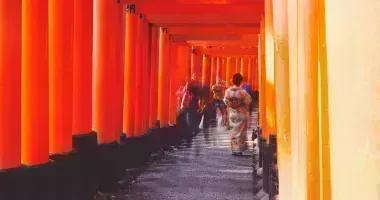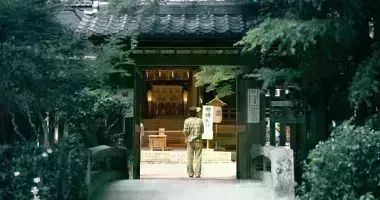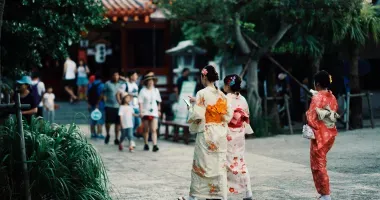When to travel to Japan? Which season to choose?
When to visit Japan?
We offer you a discovery of Japan in all seasons
"When to go to Japan " is a crucial question that any visitor to the land of the Rising Sun asks oneself. When is the best time to visit Japan? Is it going to be too hot? Too cold? Won't there be too many people? So many questions... but rest assured, we can guide you through all of your concerns.
You should know that Japan has 4 seasons as countries with temperate climates:
- Spring and cherry blossoms
- The summer and the fervor of the Matsuri
- Autumn, the koyo season
- Winter in Japan, a wonderful forgotten season
Each with its advantages and disadvantages, so when is the best time to travel to Japan?
Spring in Japan
The advantages of Japan in spring:
- In Japan, the arrival of this season is marked by cherry blossoms, mild temperatures, and a series of matsuri (festivals). It's the perfect time to enjoy flower-filled parks, whether for a picnic or a break between sightseeing.
- The pleasant climate is ideal for strolling and exploring, with temple gardens adorned in pastel hues and, by May, the vibrant green of fresh leaves. This season is so cherished by the Japanese that Spring Day, on March 21st, is a public holiday. As a result, it is undoubtedly the favorite time for tourists.
- Hanami, which means "flower viewing," has become synonymous with "watching cherry blossoms." Once an activity reserved for the imperial court and later the entire Japanese population, it has now become a global event! When the season arrives, there isn't a magazine or foreign website that doesn't mention cherry blossoms in Japan, and it seems as if people from all around the world have made a rendezvous under the blooming cherry trees.
- This season presents an opportunity for cities to organize events themed around sakura (cherry blossoms), and many locations are illuminated. In districts with geisha, it's not uncommon for them to participate in some festivities, providing a unique chance to meet them and snap a selfie! Throughout the spring, large festivals bring life to cities and villages alike.
Read also: The origins of hanami
The disadvantages of Japan in spring:
- As you might have gathered, this is also the period when the number of tourists peaks. You'll often find yourself elbowing your way through the most popular spots for cherry blossom viewing. Nevertheless, armed with a few good tips, it's easy to avoid the crowds.
- Late March and early April also coincide with school holidays in Japan: foreign visitors are joined by Japanese families. Therefore, you'll need to book hotels and sometimes transport well in advance, not to mention that prices (including airfares) increase during this popular period.
- From late April to May 5th, there are several consecutive public holidays, a period the Japanese refer to in English as "Golden Week". It provides many with the opportunity to enjoy several days of guilt-free vacation. However, this means that tourist spots are crowded, queues are endless, transport is packed, traffic jams are massive, and some prices are sky-high! Our advice, therefore, is to avoid this "Golden Week" at all costs!
- March in the Kanto region (including Tokyo) and Kyoto is often rainy. Despite the warming temperatures, it can still be quite chilly at times (especially in Kyoto), so consider packing some warm clothes. In the north (Tohoku, Hokkaido), it's still really cold.
Tip: The second half of May (May 15 to 30) is ideal due to the lack of national holidays (lesser crowds), the weather is ideal, usually warm and dry as the summer monsoons are a couple of months away.
Learn more about spring in Japan
Do you want to take a trip to Japan in March, April, May, or June? Visit the country in spring with our tours:
Summer in Japan
The advantages of Japan in summer:
- Japanese summer brings the chorus of cicadas, hanabi (fireworks), lively festivals, and a unique cuisine that's light and refreshing.
- Don't miss the many splendid firework displays organized by thousands of Japanese cities. Those in larger cities are, of course, the most well-known, but most coastal towns also host their own. Along with these pyrotechnic displays, you'll find numerous food and drink stalls, and it's a delight to see Japanese people wearing yukatas for the occasion! Just like in spring, there are numerous and diverse matsuri (Japanese festivals).
- You might also enjoy sitting on the terraces of certain cafes and restaurants (although on a much smaller scale than in France). But in Kyoto, for example, the famous kawayuka - terraces on stilts - are set up along the Kamogawa River, giving the city a new look.
- Of course, summer is the season to discover Japan's beaches and perhaps the various small islands of the archipelago, particularly in the Seto Inland Sea.
- Finally, let's not forget that summer vacations generally allow for a longer stay.
The disadvantages of Japan in summer:
- The beginning of summer coincides with the rainy season (tsuyu). From early June to mid-July, the country, with the exception of Hokkaido, experiences heavy rainfall for about six weeks.
- Summer also brings mosquitoes, intense heat, and humidity. Temperatures can easily reach 30°C in the shade, and it can be almost unbearable to walk around Tokyo... However, you can still manage with the help of fans and air conditioning, which most buildings and all modes of transportation are equipped with. It's also a great opportunity to enjoy cold soba (buckwheat noodles) and kakigōri (shaved ice).
- Tip: The northern regions, where summers are shorter, less hot, and less humid, may provide a cooler alternative for your stay and a chance to discover areas less frequented by foreign tourists.
Learn more about summer in Japan
Do you want a trip to Japan in the summer?
Visit the country during this period with our tours:
... and also our activities:
Autumn in Japan
The advantages of Japan in autumn:
- Almost as popular as cherry blossom viewing, kōyō, or the changing autumn leaves (particularly those of Japanese maple trees), adds a touch of crimson and gold to the Japanese landscape and draws crowds. Photographers delight in this season: the red and gold leaves contrast beautifully against the often very blue autumn sky, creating stunning landscapes.
- The mild climate of this time of year encourages outings into nature without having to endure the sun and humidity. Temperatures remain warm (still hot in September except in the north), and the sky is often very blue. It's the ideal season if you're deciding when to visit Japan.
- Autumn, too, is punctuated by numerous matsuri. Most of these were originally intended to thank the gods for the harvest, but they have endured and continue to enliven many Japanese cities. The Shichi-Go-San Festival (literally 7, 5, and 3 years old), which runs roughly from September to November, is also particularly photogenic: 7 and 3-year-old girls in kimonos and 5-year-old boys in hakama (traditional attire) visit Shinto shrines with their parents.
- Lastly, although this season remains relatively popular, there are significantly fewer tourists than in the spring.
Also read: Where to Admire Autumn Leaves in Japan.
The disadvantages of Japan in autumn:
- Depending on the region, September and October may see typhoons. These are usually followed by a second, shorter and less intense rainy season called akisame, which is not as severe as the summer rainy season.
- During the kōyō season, similar to the sakura season, hotel and ryokan prices in tourist areas increase drastically, and it's important to book accommodations and transportation well in advance.
Tip: The first half of October (October 1 to 15) is ideal due to the lack of holidays during this period, the weather is dry and lesser tourists.
Learn more about autumn in Japan
Do you want to travel to Japan in the fall? Visit the country with our tours:
Winter in Japan
The advantages of Japan in winter:
- Travel in winter to avoid the crowds. As the least popular season for tourists, it's also the least expensive. Airfare, hotels, and ryokan are the most affordable during this period.
- In the Kantō region, the sun often shines brightly and the sky is clear. If you don't mind the cold, the temperatures are bearable (with an average of about 10°C in Tokyo in December). It's the ideal time to travel more affordably and peacefully.
- It's also the best season to see Mount Fuji covered in snow against a blue sky. And, with a bit of luck, you can admire temples and shrines under a blanket of snow.
- Festivals are less frequent, but on the second Monday of January, seijin no hi, or "Coming of Age Day", is marked by ceremonies in Shinto shrines and provides wonderful photo opportunities. Young people who turned 20 the previous year are honored, and young women wear magnificent kimonos that they display throughout the day.
- Japan is also a prime destination for winter sports enthusiasts. In the Japanese Alps or on the island of Hokkaido, there's no shortage of ski resorts and snow-related activities. It's also the perfect time to take a warm bath in an onsen: outdoor onsens offer a truly unique experience in winter.
The disadvantages of Japan in winter:
- Aside from very cold temperatures in some regions of the country (down to -10°C in Hokkaido), a major drawback of the season is the early closure of certain sites and museums, along with the early onset of darkness (around 4:00-4:30 PM).
- Between approximately December 28th and January 5th, most Japanese people are on holiday. As with other vacation periods, hotel and ryokan prices rise, and trains and planes are heavily booked at the beginning and end of these holidays.
- Finally, potential heavy snowfall can also pose a challenge for travel.
Learn more about winter in Japan
Do you want to travel to Japan in Winter?
Visit the country with our tours:
... and also our activities:
So, "When to go to Japan ?", ultimately does not have a single answer, as it depends on the experience you desire.
We hope our tips will help you prepare for the trip to Japan you've been dreaming of.







